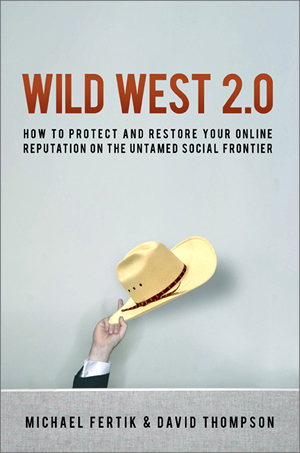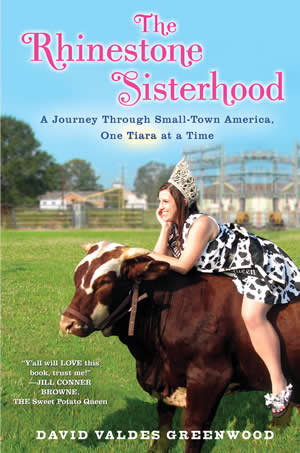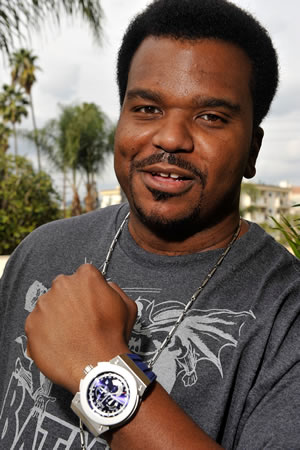c.2010, Amacom - $24.95 / $29.95 Canada - 272 pages
Book Review: Wild West 2.0
June 23, 2010 —
You’re feeling rattlesnake-mean and madder than a wild bull.
Somebody’s been messing with your reputation online, posting things that are untrue. You saw it, your clients saw it – heck, for all you know, the whole world saw it – and you’re not taking it lightly. There’ll be a showdown at the WWW-dot-Corral one day, but the problem is, you don’t know who you’re dueling with.
How can you fix this mess? Can you make sure it doesn’t happen again?
You can, according to Michael Fertik and David Thompson. In their new book “Wild West 2.0”(“Wild West 2.0”(c.2010, Amacom - $24.95 / $29.95 Canada - 272 pages), your business can survive the Technology Frontier.
Without a doubt, there are plenty of nefarious things that are done on the Internet, and you simply can’t ignore them. Even if you’re not a big fan of the web, your family, friends, and clients are.
For the most part, the online community is a good thing and its citizens behave in a civilized manner. But it takes just seconds for a juicy rumor or nasty comment to “go viral” and spread around the world for anyone to read. If you’re the target, you rarely have legal recourse.
The thing to remember is that trying to remove or squash a reputation-ruining web page only makes things worse. Search engines like Google have algorithms that put the most-viewed websites at the top of a search. Fretting, checking, and re-checking a worrisome website just raises its position. Don’t do it.
So what can you do?
“Understanding the technical nature of the Internet is the first step toward monitoring and managing your online reputation,” the authors say. Also know that, once something is online, it can move into obscurity but it will never disappear completely. Search engine companies, by the way, almost never remove postings.
To be proactive and protect your reputation, know your audience. In reality, who will view those offensive websites and who will care? Let the furor die down on its own, if possible, and ask friends to post neutral or positive things on their own sites to counteract the bad. Sign up for as many email addresses and domain names you can find, using your name and its varieties. Monitor your name on a regular basis.
Somebody rustlin’ up a heap o’trouble for your business? “Wild West 2.0” can help you put the varmints in their place.
Starting with history and a list of the good and bad that the Internet has to offer, authors Michael Fertik & David Thompson make it perfectly clear that terrible web things can happen to decent businesses and that while you have little recourse, there are steps you can take to minimize the damage. Although I’m as tech-savvy as the next person, I was stunned at the authors’ stern reminders of the power of the Internet. Who knew that a business book could be scarier than any horror novel?
If you use the Internet for business but are concerned about its downside, this book is a must-read. Having “Wild West 2.0” around is like calling in the posse.
![]() Submit a comment on "Book Review: Wild West 2.0"
Submit a comment on "Book Review: Wild West 2.0"
Book Review: Satch, Dizzy, & Rapid Robert
May 17, 2010 —
Much to your spouse’s chagrin, you can’t remember your anniversary.
When asked, you can rattle off your phone number if you think about it first. Your birthdate is an easy one, but your kids’? Not so much.
Now, your favorite baseball player’s batting average, you know that. And your team’s league standing? Piece o’ cake.
If you’re a die-hard baseball fan, you probably barely notice what your player looks like, focusing instead on what he can do with a bat, ball, or glove. In “Satch, Dizzy & Rapid Robert” by Timothy M. Gay(c.2010, Simon & Schuster – $26.00 / $34.00 Canada – 349 pages), you’ll read about men whose careers proved that stats speak louder than skin.
Although Jackie Robinson is usually credited for breaking baseball’s color barrier, the fact is that black ballplayers and white ballplayers shared the field for years before Robinson’s time. Traveling around the country to various communities, all-black “barnstormers” challenged all-white teams and drew crowds that were often bigger than Series attendance. And three headliners drew the biggest crowds of all.
Leroy “Satchel” Paige, one of the best (and perhaps best-known) pitchers of the Negro Leagues, was born into poverty. Because his family needed the income, Satch didn’t go far in school; instead, he took a job that exposed him to baseball. Intrigued, and too poor to afford a ball, Satch practiced by lobbing rocks.
When he was 12 years old, Satch was nabbed for petty theft and sent to the Industrial School for Negro Children at Mount Miegs, Alabama. The discipline he learned there changed his life. The coaching he got there made his career.
Satch’s foe and friend Jay Hanna “Dizzy” Dean also came from lean roots.
Born of sharecroppers, Diz was too poor to afford shoes as a boy, and learned to perch on the pitcher’s mound, barefoot. But once his talent was discovered, he never had to worry about shoes again. Dizzy Dean became a star, although not a humble one: he was known for driving his car around town, offering autographs.
But as Dizzy and Satch aged, there was a newcomer on the horizon.
Bobby Feller was apple-cheeked and perfect, every mother’s dream. He was a baseball manager’s dream, too, because Feller could pitch a ball so fast it almost sizzled. A life of baseball was what Feller had wanted since he was young. Signed to play while he was still in high school, “Rapid Robert” couldn’t wait to start barnstorming.
Does summer = baseball in your mind? Then “Satch, Dizzy & Rapid Robert” will be a big home run for you.
With a fans-eye view, fast-play excitement, and a casual 1930s feel, author Timothy M. Gay puts readers in the bleachers with this well-researched book. What I particularly liked is that Gay told the story of his three subjects, but he didn’t ignore those of other key people of the era. That information sometimes goes missing in books of this genre, but not here.
If you’re root-root-rooting for something good to read, catch “Satch, Dizzy & Rapid Robert”. For baseball fans, this is a book to remember.
![]() Submit a comment on "Book Review: Satch, Dizzy, & Rapid Robert"
Submit a comment on "Book Review: Satch, Dizzy, & Rapid Robert"
Book Review: The Rhinestone Sisterhood
May 3, 2010 —
Elbow, elbow, wrist-wrist-wrist.
It’s good to be Queen, but it’s hard, too. Everybody expects perfection. Letting your hair down (literally) is often forbidden. Doing the “pretend like you’re icing a cake in the air” wave makes sore arms and impressive biceps. And the cheekbone-challenging smile can never stop.
All for prestige and an unimaginably small salary.
Such is the life of the women in “The Rhinestone Sisterhood” “The Rhinestone Sisterhood” by David Valdes Greenwood (c.2010, Crown - $25.00 / $29.95 Canada - 277 pages), and as you’ll see in the new book by David Valdes Greenwood, thousands of girls around the country aspire to it each year.
Before a girl sets her head on wearing a crown, she needs to decide how she’s going to get it. In Louisiana, as in many parts of the country, there are four varieties of pageant: festival (think: Milk Queen); civic (basically, a paid job); scholarship (Miss USA or Miss America); and glitz (where “Jon-Benets of all ages fork over cash to vie for meaningless crowns…”). This book is about the first kind of Queen.
When Chelsea was a little girl, she badly wanted to be Rayne Frog Queen. At a size zero, “like a sparrow wrapped in pink silk”, she was quiet and shy, the kind of girl who hated public speaking. So when one mistake almost made her dream hop away, she surprised everybody – even Chelsea – for finding the guts to stand up for herself.
Lauren, the current Fur Queen, had been a festival queen during her entire college career. After all those years of absolutely no free time, a severely ill sister, and warring parents, she was looking forward to a respite at the end of her reign, but Hurricanes Rita and Ike had other ideas.
Kristen, says Valdes Greenwood, has one “setting”: herself. Exuberant and willing to do anything in her position as Cattle Queen (that’s her on the book’s cover), she jumps in with both flip-flopped feet. But the negativity-fueled Voy boards (an online forum filled with snark) had plenty to say about her reign.
Beautiful Brandy had an on-again, off-again career as a Queen; first as Miss Andouille, then Yambilee Queen, and now Cotton Queen. Expected to place in the Top 15 in the Queen of Queens pageant, Brandy knows the pressure’s on…
Think it’s easy being Queen? “The Rhinestone Sisterhood” will show you that the job is real work and being royalty can be a royal pain.
With an unfettered insider’s view of the inner workings and the drama of small-town festivals, author David Valdes Greenwood pulls aside the velvet curtain to reveal a tradition that is de rigueur for every little burg and borough in the U.S. and Canada. Because he let the Frog Queen have warts and because he called things as he saw them otherwise, I think this book would be a crown jewel on anybody’s bookshelf.
If you’ve got plans for parade-viewing this year, wave at the girls in silk and tulle, then read this book. For Queens - former, current, or future - “The Rhinestone Sisterhood” is a book to get your satin-gloved hands on.
![]() Submit a comment on "Book Review: The Rhinestone Sisterhood"
Submit a comment on "Book Review: The Rhinestone Sisterhood"
Book Review: Stuff - Compulsive Hoarding and the Meaning of Things
April 21, 2010 —
You’ve been looking for something for days. The last time you had it, you put it down here. Right over here, and now you can’t find it.
But that’s no surprise. You’re always shifting a pile of something from table to counter to desk and back, and things get lost. As soon as you get some of those plastic bins, you’ll get organized. A little mess is normal, right?
That depends on how much is “a little”. In the fascinating new book “Stuff: Compulsive Hoarding and the Meaning of Things” by Randy O. Frost & Gail Steketee, you’ll see how possessions could make a mess of your life.
It seems like we all know somebody who fits the description of packrat: recent studies show that between 2 and 5 percent of our population hoards. Take, for instance, the friend who never throws away paper, ever. The relative who can’t pass up a dumpster. The local “cat lady”. The neighbor whose yard is worse than the town dump.
Maybe the packrat is you.
No matter where the mess is or how it got there, Frost and Steketee indicate that most hoarders are embarrassed and ashamed about their messes. Many decide to seek help from psychiatrists and professional organizers because their families are suffering or frustrated (or both). Online, there is a chatroom specifically for hoarders; only a limited number of members are accepted and the waiting list is hundreds long. In this book, the authors profile several of their most memorable cases.
Frost and Steketee say that hoarding is a facet of Obsessive Compulsive Disorder, or OCD. Generally speaking, people who have hoarding problems hate to think of anything being wasted. They sometimes keep objects because of memories attached to them, and though elaborate stories are often linked to the objects, hoarders are often afraid of losing those memories if they lose the objects. Hoarders are often perfectionists, they never pass up a chance to add to their “collection”, many are seriously in debt because of their inability to stop shopping, and some can’t stop “shopping” in a dumpster. And if they truly want to change, there’s help for them all.
Hooked on hoarding shows? Yeah, me too, and I was equally mesmerized by this irresistible book.
Authors Randy O. Frost & Gail Steketee are extremely respectful of the hoarders they mention in their book, but they likewise manage to convey their own fascination and intrigue with their subjects. Along the way, they sprinkle info-tidbits like dust, including the fact that 90% of children collect, hoarding may be hereditary, and that researchers believe they can pinpoint where the tendency to hoard resides in the brain. I was chair-bound as I read this amazing book and I mourned when I finished it because I didn’t want it to end.
If you’re up for a riveting read, sweep into your bookstore or library and snatch a copy of “Stuff”. Whether you’re a messy or a neatnik or somewhere in between, this book leaves all others in the dirt.
![]() Submit a comment on "Book Review: Stuff - Compulsive Hoarding and the Meaning of Things"
Submit a comment on "Book Review: Stuff - Compulsive Hoarding and the Meaning of Things"
















